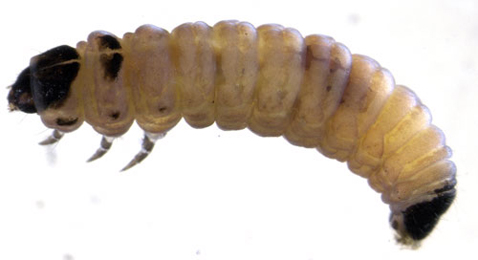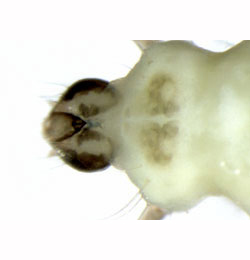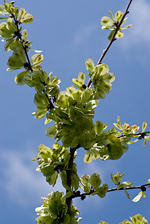|
||||||
|
ULMUS. Elms. [Ulmaceae] |
|
|
Eighteen species, subspecies and hybrids of Ulmus are recorded in Britain. These include English Elm (U. procera) and Wych Elm (U. glabra). Eighteen British miners are recorded on Ulmus. A key to the European miners recorded on Ulmus is provided in Bladmineerders van Europa. |
|
Key for the identification of the known mines of British |
1a > Leaf-miner and case-bearer: The larva lives outside the mine, protected by a case, and feeds on the underlying plant tissues via a hole cut in the epidermis. From that point it eats away as much leaf tissue as it can reach without fully entering the mine. Mine does not contain frass (Coleophora species) |
1b > Bark-miner or leaf-miner, but not a case-bearer: The larva lives mainly inside the mine. Mine usually contains frass. In later instars the larva may live sandwiched between two more or less circular sections cut from the leaf. |
2a > Leaf-miner and case-bearer: The larva initially forms a gallery along the midrib, which then goes out along a vein. The end of this gallery is then excised to construct the first case. It then feeds close to this and makes several small mines. The final case is a small, laterally compressed, squat, spatulate leaf case of 5-6 mm. The dorsal keel has some serrations, remnants of the leaf margin out of which the case was cut. The rear is twovalved, and remarkably broad. The mouth angle is 0-10°. The description and illustration of the final case in Emmet et al. (1996a) is not quite clear. They depict a rather slender case, and state that the mouth angle is 30°. But, as the only illustration in the other literature that would agree with the British badiipennella, they refer to Hering (1957a, fig. 701): this illustration, however, has no resemblance to their own figure, and has a mouth angle of c. 0°. Emmet et al. write that the larva begins its life by making a gallery of 10-15 mm that runs from the midrib along a side vein; out if this mine the first youth case is excised. |
|
Coleophora badiipennella (Duponchel, 1843) [Lepidoptera: Coleophoridae]. |
2b > Leaf-miner and case-bearer: This species produces a distinctive larval case in its later stages with a noticeably serrated upper edge, and affixed almost parallel to the leaf surface. The larvae overwinter when small and recommence feeding in late spring. Oviposition generally in a vein axil. From there a short, relatively wide corridor is made that quickly widens into an elliptical blotch. Much of the frass is ejected through the hole that the larva has made to bore itself into the leaf (in C. badiipennella, on the same host plant, the frass remains within the mine. This blotch is excised to make the juvenile case. The full grown larva lives in a brown spatulate leaf case of 9-11.5 mm; its rear end is bivalved. Mouth angle 0°-20°; just behind the mouth the case shows a conspicuous bend. |
|
Coleophora limosipennella (Duponchel, 1843) [Lepidoptera: Coleophoridae]. |
2c > Leaf-miner and case-bearer: The larva feeds by inserting its head into small mines it creates on the leaves of birch, elm, alder, or hazel. Occasionally it is found feeding on other trees, or on herbaceous plants onto which it has accidentally Fallén. It forms two cases during its larval life. The first case is initially curved, smooth, laterally compressed with a bivalved anal opening, and about 2 mm long in September. During October it feeds, and adds a few rough collars of larval material around the oral opening. After hibernation, it feeds again in April and early May, adding more protruding collars until they equal or exceed the original smooth part of the case. At the same time, it expands the case girth by the creation of a silk gusset ventrally. The second case, 6 or 7 mm long, is formed in May, leaving the vacated first case attached to its last feeding mine. The new case is tubular with a trivalved crimp at the anal opening. The dorsum is formed from the edge of the leaf from which the case was cut. This results in a more or less serrated dorsal keel, depending on the plant species and the individual piece of leaf used. Considerable variation in the degree of serration can be found, even among specimens off the same tree. The case colour varies with food plant, from yellowish brown on birch, darkening through elm and hazel to dark brown on alder. The strongly curved young case is is a composite leaf case, the adult case is a tubular leaf case. The adult case is bivalved, about 7 mm in length; the mouth angle is around 30°. The case is straw coloured and almost always has a toothed dorsal keel (remnant of the margin of the leaf from which the case was cut). Neither larvae or cases of C. coracipennella, prunifoliae, serratella and spinella can be separated; from serratella. |
|
Coleophora serratella (Linnaeus 1761) [Lepidoptera: Coleophoridae]. |
2d > Leaf-miner and case-bearer: The larva feeds on a wide range of trees, shrubs and herbs, favouring Rosaceae, but not exclusively. The fully developed cased larva may be found active in October and again, after winter diapause, in April. Cases, about 6 mm, of diapausing larvae may be found through winter, fixed to a tree or fence post. The dorsal surface of the case is usually covered in leaf fragments, but they can sometimes be worn off almost smooth. The ventral surface is swollen at the middle and has a keel, which usually bends upwards at the posterior. The cases of C. ahenella (on Rhamnus, Frangula, Viburnum and Cornus) and C. potentillae (case less swollen, keel not bent up, resting position less prone) are very similar. Brownish lobe case that lies almost flat on the leaf, either on the upper or on the lower side. Case widest about the middle. Ventrally there is a distinct keel. Mouth angle 0°. Full depth mines rather large. The flaps of cuticular tissue that serve to enlarge the case are cut out of the upper epidermis. (contrary to C. ahenella and C. potentillae, that use tissue from the lower epidermis). The removal of these tissue flaps creates holes that are much larger than those that serve as the entrance to the mine. |
 Coleophora violacea larva, lateral Image: © Willem Ellis (Bladmineerders van Europa) |
|
Coleophora violaceae (Ström 1783) [Lepidoptera: Coleophoridae]. |
3a > Bark-miner: The long mine is found in the bark of thin branches of Elm. Little known of the life history. |
|
Ectoedemia amani Svensson, 1966 [Lepidoptera: Nepticulidae]. |
3b > Leaf-miner: A very clear blotch, without preceding corridor, usually harbouring several crimson marbled larvae. The mine mostly begins near the base of the midrib. Most frass is ejected from the mine, but some of the grains are trapped in a loose spinning below the leaf, that has been made by the larvae during excursions. The larvae can leave their mine and restart elsewhere. The larvae hibernate individually in a discoid cocoon. The larva overwinters within a cocoon spun in the leaf. |
|
Atemelia torquatella (Lienig & Zeller, 1846) [Lepidoptera: Yponomeutidae]. |
3c > Leaf-miner: Winding full depth corridor up to 15 mm long with a long larval chamber. Black frass in a central line, broad, but leaving a clear zone at either side. Characteristically the corridor has 2-4 short, frass-free, side branches (diverticula) occurring at points where the main corridor makes a sharp turn. The first one often is interparenchymatous tissue and difficult to see; the following turns usually have opening in the lower epidermis at their end. Older larvae live free on the leaf, creating windows; the exit hole is in the underside of the leaf. The larva pupates in an oval cocoon. |
|
Bucculatrix albedinella (Zeller, 1839) [Lepidoptera: Bucculatricidae]. |
3d > Leaf-miner: Starts as a contorted frass-filled gallery, between the midrib and vein. Later the gallery, with broken black frass, follows a vein before turning away. The final mine is 11-15 mm long.. Oviposition on the leaf underside, generally in the axil of the midrib and a thick lateral vein. The very first part of the mine is so strongly contorted that sometimes a tiny secondary blotch originates, filled with black frass. Then follows a straight corridor of maximally 15 mm, almost completely filled with frass, mostly closely following a vein. Just before the larva is about to leave the mine (through an exit hole in the leaf underside) it turns away from the vein. Pupa dark blackish brown, in a grey-black, ribbed cocoon (Langmaid, Porter and Collins, 2007). |
|
Bucculatrix ulmifoliae M. Hering 1931 [Lepidoptera: Bucculatricidae]. |
3e > Leaf-miner: A rather large, clear, partly full depth blotch that begins in the axil of a thick lateral vein. Often the ovipostion leaves a greyish-green scar. Generally several mines in a leaf. The mine expands within the confines of the midrib and two lateral veins; only close to the leaf margin, where the lateral veins are thin, the mine may trespass over a vein. The larvae of sawflies have at least six thoracic legs (although they may be reduced or absent), a head capsule and chewing mouthparts with opposable mandibles but no abdominal legs. |
|
Fenusa pumila Leach, 1817 [Hymenoptera: Tenthredinidae]. |
3f > Leaf-miner: A long, whitish smoothly-curved upper-surface mine with broken black frass. Oviposition is by means of an ovipositor; what remains is a small scar: no egg shell is visible at the start of the mine. From here a long, sometimes very long, slender, full depth corridor winds throught the leaf, not steered by leaf margin or the leaf venation. The midrib is crossed effortless; the corridor frequently also crosses itself; the section of the leaf cut off then usally turns brown and dies off. Frass in a narrow central line. The larva vacates the mine prior to pupation through an exit in the upper epidermis. The vacated larval chamber is proportionally much longer than in the case of Stigmella mines ( > 3 x longer than broad). Pupation in a silken cocoon suspended from threads attached to food plant or other vegetation. |
|
Lyonetia clerkella (Linnaeus, 1758) [Lepidoptera: Lyonetiidae]. |
3g > Leaf-miner: Oviposition in the underside of the midrib; here an extensive scar remains visible. From this point a full depth corridor runs towards the leaf tip, where it widens to a blotch. The larva eventually pupates in a globular cocoon, made inside the mine. Because the mine is made at a time the leaf still is unfolding, the leaf can be strongly disfigured. |
|
Orchestes alni (Linnaeus, 1758) [Coleoptera: Curculionidae]. |
3h > Leaf-miner: The mine is oval, sometimes crossing veins. The lower epidermis with several strong creases. Along with P. tristrigella, this species feeds on elm, although not usually on wych elm like that species. However the two mines are quite different - schreberella forming a rounded mine and tristrigella a longer, narrower tube-like mine. Short, roundish to oval, somewhat inflated, lower surface tentiform mine, often crossing a lateral vein. Epidermis with several length folds. Dark brown pupa in a tough, greenish cocoon; the cocoon lies free in the mine, and its wall is not encrusted with frass. |
|
Phyllonorycter schreberella (Fabricius, 1781) [Lepidoptera: Gracillariidae]. |
| 3i > Leaf-miner: The mine is long and narrow, tubular, caused by strong contraction. The lower epidermis with several strong creases. Long, lower-surface tubular tentiform mine between two lateral veins, in many cases from midrib to leaf margin. Lower epidermis with several long folds close together. Pupa light brown, in tough brown papery coccoon that is attached to the lower epidermis. All frass in a mass in one corner of the mine. |
 Phyllonorycter tristrigella larva, dorsal Image: © Willem Ellis (Bladmineerders van Europa) |
|
Phyllonorycter tristrigella (Haworth, 1828) [Lepidoptera: Gracillaridae]. |
3j > Leaf-miner: The frass is dispersed in early part of mine. Oviposition at upper or lower surface. Rather slender corridor mine, hardly widened in the end. The corridor often follows the leaf margin for some distance. The first section of the corridor is almost entirely filled with frass. Frass in the later part of the mine in more or less clear coils. Pupation external; exit slit invariably in upper epidermis. |
|
Stigmella lemniscella (Zeller, 1839) [Lepidoptera: Nepticulidae]. |
3k > Leaf-miner: The frass is linear in early part of mine. Egg at the underside of the leaf, generally near a vein. The mine is s slender corridor. Frass in its first part in a narrow central line. The frass pattern in the later segment is very variable: sometimes in a narrow central line, sometimes broadly dispersed or even coiled. Especially in the latter case confusion with St. lemniscella is hard to avoid. The only reliable character that remains then is that the exit slit is in the lower epidermis. |
|
Stigmella ulmivora (Fologne, 1860) [Lepidoptera: Nepticulidae]. |
3l > Leaf-miner: A contorted, “gut”-shaped gallery. The fresh frass is reddish in colour. Very compact upper or lower side mine; a strongly contorted corridor in intestine-like, zigzagging loops; only the very last part of the corridor is free. Frass in the first and in the final part of the mine black, warm brown and coiled in the central section, and, except for the last section, occupying the entire width of the corridor. Fresh mines have a striking red brown colour. |
|
Stigmella viscerella (Stainton, 1853) [Lepidoptera: Nepticulidae]. |
3m > Leaf-miner: Full depth blotch, invariably beginning at the leaf tip or the tip of a leaf lobe or tooth. Oviposition site covered by a black, shining drop of hardened secretion. Frass generally in long threads, but sometimes in elongated granules. Pupation in the mine, not in a cocoon. |
|
Trachys minutus (Linnaeus, 1758) [Coleoptera: Buprestidae]. |
3n > Leaf mine: Very clear blotch, containing a yellow white larva. The final mine may occupy a sizable part of the leaf. The mine usually starts in a vein axil, never at the leaf margin (Liston, 1994a); in large leaves the mine remains confined between to lateral veins. Frass in black grains, initially often in long pearl chains, in older mines in loose grains. The larvae of sawflies have at least six thoracic legs (although they may be reduced or absent), a head capsule and chewing mouthparts with opposable mandibles but no abdominal legs. |
|
| Fenusa ulmi Sundevall, 1847 [Hymenoptera: Tenthredinidae]. |
| Last updated 08-Jul-2019 Brian Pitkin | ||

